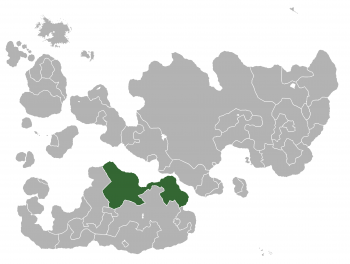Tashkveny
| The Commonwealth of Tashkveny Co-fhlaitheas na Taghan (Gaelic) Le Commonwealth de Tashkvéné (French) Tashkveny | |
|---|---|
 Flag | |
Motto: United as One | |
Anthem: Thegither, we staund | |
 Location of Tashkveny in Internatia. | |
| Capital and largest city | Invertulloch |
| Official languages | English, French, Scots Gaelic |
| Recognised national languages | Korean, Grolskiric |
| Demonym | Tashken |
| Government | Federal Parliamentary Constitutional Monarchy |
• Monarch | Queen Alexandria I |
• Prime Minister | Darren Smith |
| Formation | |
• Founding as Kingdom | c.843 |
• Tashken Revolution | March 19, 1893 |
• Communist Coup d'état | May 1, 1940 |
• Establishment of Federal Republic | September 1, 1990 |
• Adaption of Current Constitution | March 19, 2014 |
| Area | |
• Total | 684,424 km2 (264,258 sq mi) (4th) |
| Population | |
• 2014 estimate | 157,221,597 (1st) |
• 2011 census | 154,579,641 |
• Density | 225/km2 (582.7/sq mi) |
| GDP (PPP) | 2011 estimate |
• Total | $4,910 billion |
• Per capita | $31,763 |
| GDP (nominal) | 2011 estimate |
• Total | $8,401 billion |
• Per capita | $54,347 |
| Gini (2011) | 0.34 low |
| HDI (2011) | 0.966 very high · 9 |
| Currency | Tashken prinar (₱) (TKP) |
| Time zone | Southern Internatian Time (UTC+2) |
• Summer (DST) | Southern Internatian Summer Time (UTC+3) |
| Date format | DD/MM/YYYY |
| Drives on the | left |
| Calling code | 422 |
| Internet TLD | .ty |
Tashkveny, officially the Commonwealth of Tashkveny (French: Le Commonwealth de Tashkvéné; Scots Gaelic: Co-fhlaitheas na Taghan) is a sovereign state located in southern Internatia. Tashkveny is bordered by Grolskira to the west, Ova Anova to the south-west, DPR Jindalea to the south (with which it shares the majority of its border) and Rata Sum in the extreme south-east by land, and Volnytaria, Amsteris, Holy Kim Jong Il's After Death Hangug, Tjärsklanjska, Sockistan, San Remo and a short border with Kosma by sea.
Tashkveny has a total landarea of 684,424 square kilometers and a population of 157 million. This makes Tashkveny the 4th largest country in Interatia, but the most populous nation Tashkveny is a multiethnic society, encompassing a wide variety of religions, languages and cultures. This pluralistic make-up is recognized through its recognition of 3 national languages: English, French and Scottish Gaelic, along with 4 regional languages with varied support at national and federal level: Grolskiric, Korean, Spanish and Spirevan. Tashkveny is a multi-lingual society, with citizens able to speak at least 2 languages.
Archaeological research indicates that people lived in Tashkveny as far back as 10,000 years ago. The first written mention of Tashkveny is found in texts discovered in the Jindalean Peoples archives in 2007, which was written in the 1st century AD. Influence from other nations has long shaped the nation, which lies on the northern edge of the Southern Internatian Continent, and so was the first point of contact for those travelling by sea from the north. This contact and influence has made Tashkveny what it is today.
Tashkveny is a Federal Parliamentary Constitutional Monarchy, comprised of 10 provinces; Inisheer, Cairngorm, Guienne, Mointichean, Richelieu, Lochalsh, Lambersart, Balivanich, Kinross, Tannadice and 5 federal cities; Invertulloch, Montrose, Laomainn, Bonaventure and Gatoche. Within these provinces are also devolved local councils, numbering 1,306 by 2014. All 15 of these entities have their own Legislatures, along with representation in the Tashken Parliament, however, this is not offered to local councils, who report instead to provincial governments.
Tashkveny as a nation also has one of the highest standards of living in Internatia, as well as one of the best economies, leading to economists to term Tashkveny's economic rise as the "Tashken Tiger".
History
As a nation, Tashkveny has existed in various forms over the past 1,000 years. From around the 5th century, the present nation of Tashkveny was split amongst several small kingdoms, dotted around the Tashken Sea coast. Beginning in the 7th century, these small kingdoms began to merge, until by the early 9th century, only two remained, the Kingdom of Invertulloch and the Kingdom of Arcaibh. Through a series of Wars between both nations, the Kingdom of Arcaibh was eventually incorporated in to the Kingdom of Invertulloch, and in 843, the Kingdom of Tashkveny was born, under the rule of King Cínead.
The crown remained the most important element of government throughout the history of the kingdom, despite the many royal minorities. In the late Middle Ages, the crown saw many of the aspects of aggrandisement associated with "new monarchy". The Tashken monarchy in the Middle Ages was a largely itinerant institution, Invertulloch remained one of its most important locations, with royal castles at Gatoche and Bonaventure becoming significant in the later Middle Ages before Edinburgh developed as a capital in the second half of the fifteenth century. The court remained at the centre of political life and in the sixteenth century emerged as a major centre of display and artistic patronage. The Tashken crown adopted the conventional offices of many Internatian courts. The Privy Council and the great offices of state had developed by the sixteenth century. Parliament also emerged as a major legal institution, gaining an oversight of taxation and policy. Before 1764, Tashkveny remained an absolute monarchy, under the rule of the MacPhaig monarchy.